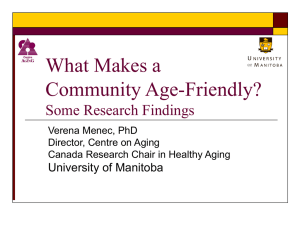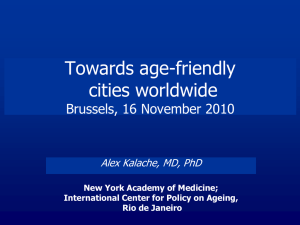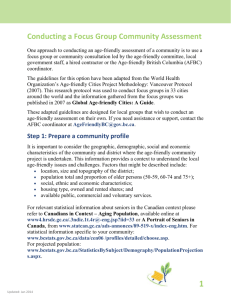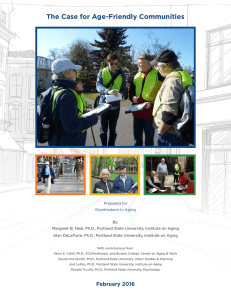Summer 2012 By Edward F. Ansello, Ph.D. Walkability
advertisement
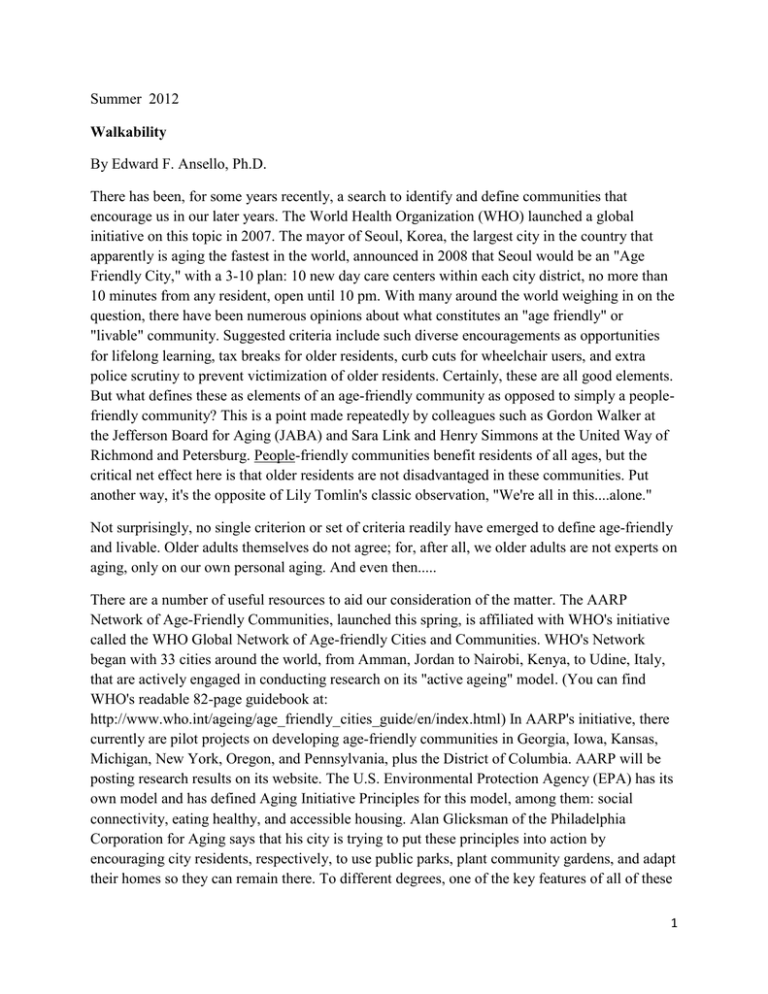
Summer 2012 Walkability By Edward F. Ansello, Ph.D. There has been, for some years recently, a search to identify and define communities that encourage us in our later years. The World Health Organization (WHO) launched a global initiative on this topic in 2007. The mayor of Seoul, Korea, the largest city in the country that apparently is aging the fastest in the world, announced in 2008 that Seoul would be an "Age Friendly City," with a 3-10 plan: 10 new day care centers within each city district, no more than 10 minutes from any resident, open until 10 pm. With many around the world weighing in on the question, there have been numerous opinions about what constitutes an "age friendly" or "livable" community. Suggested criteria include such diverse encouragements as opportunities for lifelong learning, tax breaks for older residents, curb cuts for wheelchair users, and extra police scrutiny to prevent victimization of older residents. Certainly, these are all good elements. But what defines these as elements of an age-friendly community as opposed to simply a peoplefriendly community? This is a point made repeatedly by colleagues such as Gordon Walker at the Jefferson Board for Aging (JABA) and Sara Link and Henry Simmons at the United Way of Richmond and Petersburg. People-friendly communities benefit residents of all ages, but the critical net effect here is that older residents are not disadvantaged in these communities. Put another way, it's the opposite of Lily Tomlin's classic observation, "We're all in this....alone." Not surprisingly, no single criterion or set of criteria readily have emerged to define age-friendly and livable. Older adults themselves do not agree; for, after all, we older adults are not experts on aging, only on our own personal aging. And even then..... There are a number of useful resources to aid our consideration of the matter. The AARP Network of Age-Friendly Communities, launched this spring, is affiliated with WHO's initiative called the WHO Global Network of Age-friendly Cities and Communities. WHO's Network began with 33 cities around the world, from Amman, Jordan to Nairobi, Kenya, to Udine, Italy, that are actively engaged in conducting research on its "active ageing" model. (You can find WHO's readable 82-page guidebook at: http://www.who.int/ageing/age_friendly_cities_guide/en/index.html) In AARP's initiative, there currently are pilot projects on developing age-friendly communities in Georgia, Iowa, Kansas, Michigan, New York, Oregon, and Pennsylvania, plus the District of Columbia. AARP will be posting research results on its website. The U.S. Environmental Protection Agency (EPA) has its own model and has defined Aging Initiative Principles for this model, among them: social connectivity, eating healthy, and accessible housing. Alan Glicksman of the Philadelphia Corporation for Aging says that his city is trying to put these principles into action by encouraging city residents, respectively, to use public parks, plant community gardens, and adapt their homes so they can remain there. To different degrees, one of the key features of all of these 1 efforts is their focus on community rather than just on aging individuals. This is, of course, realpolitik, acknowledging that appropriating bodies seem to be less willing to target just one constituency when there are fewer resources to expend overall. But, more importantly, these initiatives attempt to reverse the age-segmentation that, ironically, may have contributed to the problems in the first place. My colleague Dana Bradley at Bowling Green University is partnering with community activists and elected officials in the small city of Bowling Green, Kentucky, the first Southern city in the U.S. to be accepted into the WHO Global Network, which offers a platform to exchange ideas and learned experiences with others in the Network around the world. Dana and her partners are seeking over the next several years to implement and study WHO's core aging-related features that WHO maintains are "intended to provide a universal standard for an age-friendly city." The eight core features address aspects of daily life: Outdoor Spaces and Buildings; Transportation; Housing; Social Participation; Respect and Social Inclusion; Civic Participation and Employment; Communication and Information; and Community Support and Health Services. The WHO guidebook offers the findings from focus groups around the world that collectively give substance to what each of these features really means in everyday living. For instance, under Outdoor Spaces and Buildings the checklist, with many detailed examples, includes there being a pleasant and clean environment; the importance of green spaces (that are safe to visit); somewhere to rest; age-friendly pavements; safe pedestrian crossings; accessibility; a secure environment; age-friendly buildings (railings, ramps, wide doorways); and more. Transportation is the feature that elicited from the focus groups around the world the greatest number of examples to emulate, 16 in all. Certainly, many of us are aware that getting in and out of our communities safely and affordably is both necessary and desirable for many reasons, from economic to physical health to mental well being. The absence of this feature connotes the worst extreme of aging in place. The WHO guidebook cites these examples of transportation in agefriendly cities: availability; affordability; reliability and frequency (transport that is there on weekends and doesn't take forever to reach a destination); travel destinations (going where people want to go); age-friendly vehicles (accessible); priority seating for people with special needs; transport stops and stations kept in good condition; information (ready access to timetables, routes); courtesy to older drivers; priority parking; and more. One can clearly see that the criteria that WHO and AARP offer for an age-friendly community really speak to what would constitute a desirable place for all members of the community, young and old, working and not working. A starting point, in my mind, for assessing how friendly or livable a community is, is to consider its walkabilty. Many of the features listed above convert or relate to walkability. By walkability I do not mean the requirement that one be able to stand and place one foot in front of the other. Rather, I mean that, among other things, there be features in the community that would motivate a person to want to visit or take advantage of them. 2 Walkability seems to be a common denominator across several sets of criteria established by AARP, EPA, and WHO. AARP's Livable Communities: An Evaluation Guide (2005) even has a section on it. Walkability has different dimensions, for it implies not only that there be amenities in the community to which one would want to go, but also that one can move about safely; that the person motivated would have the health status or needed support to move about; that there would be means of transportation within and outside of the community, such as public transportation and taxis; and so on. Walkability is not the single simplistic answer but it appears to me to be a fairly understandable yardstick to begin measuring what we in the aging network need to do in partnership across the generations to identify and create livable communities that are all-people-friendly. 3
